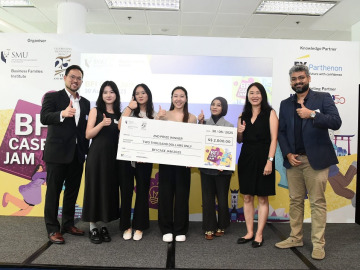Language barriers and barriers to mutual cultural understanding
Graduate School Graduate School of Asia-Pacific Studies Master's Program, September 2024 Graduate, Masaharu Kobayashi
 A child with foreign roots is not only someone who has a blood relationship or cultural background outside of the country, such as having at least one parent, grandparent, or ancestor who is from a foreign country, but also someone who emigrated from a foreign country at a young age. In the summer of my second year of junior high school, my family decided to move to Georgia in the United States, and to people living in the United States, I also became a child with foreign roots.
A child with foreign roots is not only someone who has a blood relationship or cultural background outside of the country, such as having at least one parent, grandparent, or ancestor who is from a foreign country, but also someone who emigrated from a foreign country at a young age. In the summer of my second year of junior high school, my family decided to move to Georgia in the United States, and to people living in the United States, I also became a child with foreign roots.
I remember that for a few months after arriving in the United States, I couldn't speak English well, and coupled with the fact that I was in my teenage years, I felt disgusted and lonely about not being able to fit in at school. I remembered this feeling when I was in my third year of university. I met a child with foreign roots while working part-time at an after-school care center, which I had started in my first year of university.
The child had only recently come to Japan from abroad, and there were language and cultural barriers between him and the other children, which seemed to cause him stress when it came to communicating with them. However, what was different from my experience was that ICT education has now spread to elementary schools, and children are provided with electronic devices such as tablets. I began to think that by using these electronic devices, it would be easier to overcome language and cultural barriers, as they would be able to use the translation function and instantly look up words they don't understand. This is why I decided to go on to graduate school and conduct research on the theme of "ICT and education for children with foreign roots and challenges: changes in Japan's educational environment and future challenges."

Image of ICT education
First, from previous literature, we learned that the number of children with foreign roots in Japan has been increasing rapidly in recent years, and that many of them face more challenges than Japanese children, such as bullying at school, feeling out of place, and lack of communication with Faculty. We also learned that the widespread use of electronic devices has made it easy to use translation functions such as voice translation, and that the linguistic support environment in educational settings has been improved to a certain extent.
As part of my own research, I conducted interviews with elementary and junior high school Faculty and participant observation of classes to investigate the current state of ICT education and children with foreign roots. Based on data showing that Kanagawa Prefecture is a region with a large number of foreign residents, where ICT education is actively being introduced, and that public schools tend to have many children who need Japanese language instruction, I began my research mainly in public schools in Kanagawa Prefecture. However, it was difficult to coordinate schedules with Faculty, and there was also the need to protect the privacy of children, so it was very hard to find subjects for my research. I am very grateful to the people who cooperated with me despite the difficulties.
*The researcher joins the society or group that is the subject of the research and observes it over a long period of time.

The books next to my PC are useful as prior literature: "Newcomers and Education: Concerning the Conflict between School Culture and Ethnicity" edited by Shimizu Koukichi and Shimizu Mutsumi (Akashi Bunko), and "Foreign Children and Japanese Education: The Problem of Non-Attendance and the Challenges of Multicultural Coexistence" edited by Miyajima Takashi and Ota Haruo (University of Tokyo Press).
The survey found that, in addition to the impact of language barriers, the challenges faced by children with foreign roots are also largely due to a lack of mutual cultural understanding caused by the lack of opportunities to learn about the cultures of countries other than Japan in the Japanese educational environment, and the fact that Faculty have few opportunities to learn about the home environments and reasons for migration of children with foreign roots, which results in them being treated the same as other children.
On the other hand, one effect of ICT education is that it has become easier for students to understand foreign cultures, as they can now easily research things that interest them using electronic devices. The use of ICT also allows Faculty to visualize students' opinions, making it easier to see which students understand the lesson content and which do not. Furthermore, it was found that this provides an opportunity for students to confirm each other's opinions and learn about other people's thinking, which has led to improved communication and deepened mutual understanding between children with foreign roots and those born and raised in Japan.

Working on an assignment in the lounge of Building No. 19 on Waseda Campus, where Graduate School of Asia-Pacific Studies is located.
Through my life and research at graduate school, I was reminded once again that "education" has a major influence on people's lives. And society is formed and functions when people who have received that education come together. For this reason, it is no exaggeration to say that "education" is the foundation of society. I hope that this research will support education in the future, even if it is a small contribution. I also want to be someone who can support education in the future.
Daily Schedule
- 08:00 Wake up, breakfast
- 10:30 Class
- 12:00 Lunch
- 13:00 Class
- 17:30 Dinner (On days when I have classes, I often go out to eat with my classmates)
- 18:30 Assignment
- 19:30 Bath (this helps me to refresh myself when I'm stuck on an assignment)
- 20:30 Assignments and research activities
- 22:00 Hobbies (watching movies and anime, reading novels)
- 24:00 Bedtime






![[Save version] Map of the four main campuses](https://www.waseda.jp/inst/weekly/assets/uploads/2025/09/17cb2975123fc5103172ef60bd98608d-610x458.jpg)

